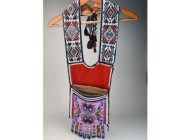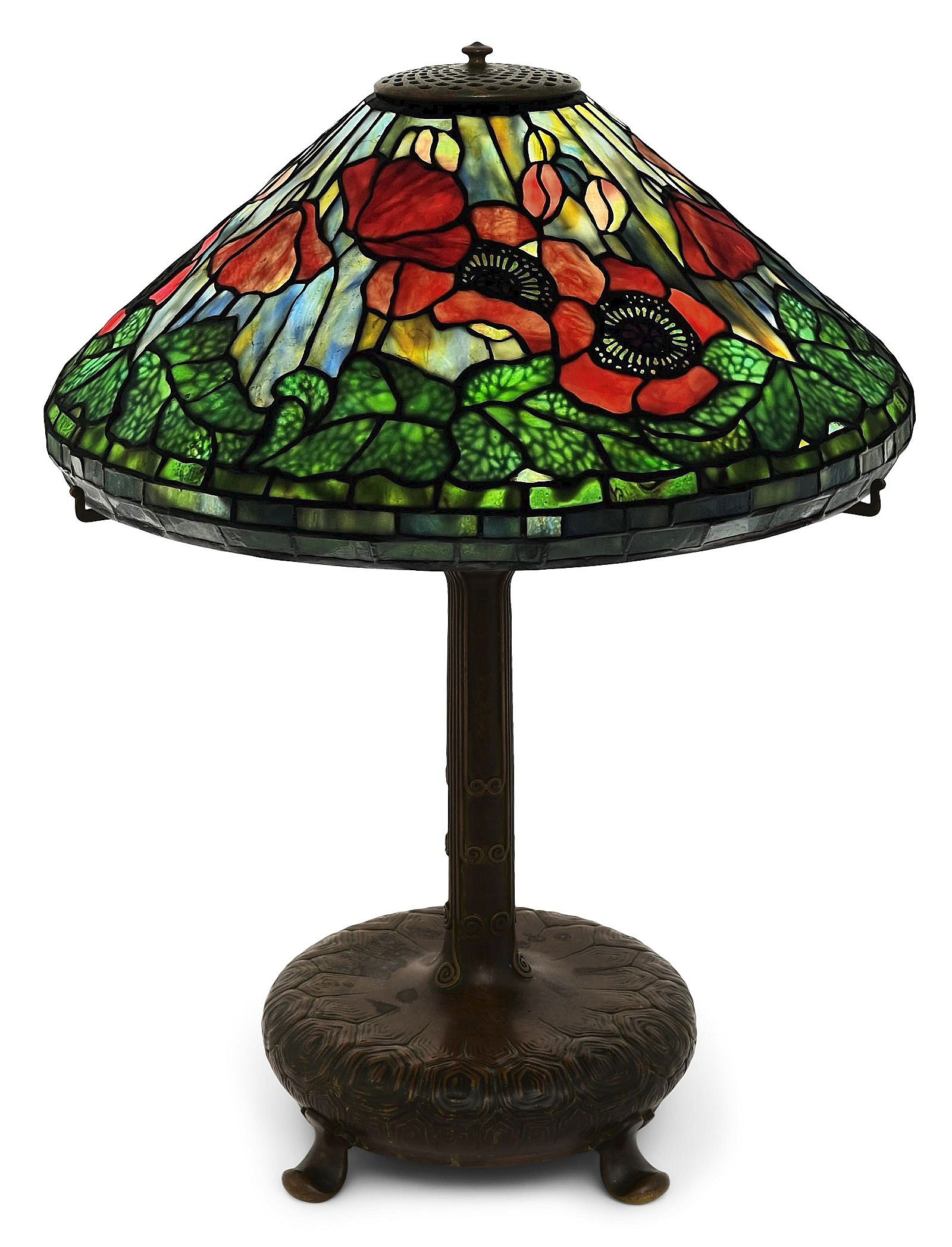
The bold reds, greens and blues of this Poppy table lamp attracted collectors. The circa 1905 lamp was signed on both the shade and the base and it realized $93,750, the highest price of the sale.
Review and Onsite Photos by Rick Russack, Additional Photos Courtesy Fontaine’s Auction Gallery
PITTSFIELD, MASS. – John Fontaine’s two-day sale, September 24-25, included 45 Tiffany lamps and that was just the beginning. There were more than ten Pairpoint lamps, 17 Handel lamps, other lighting, art glass, leaded glass windows, silver, porcelain, marble and bronze statuary, paintings – both American and European, furniture and some jewelry. Nearly all items were those that had possibly furnished the homes of the well-to-do citizens of the Gilded Age.
A few days before the sale, John Fontaine discussed his company and the current state of the market for the material in which he specializes. It’s a subject he’s well qualified to discuss, having been in the auction business for more than 50 years.
Fontaine said, “The market for our material is strong and steady now, and we’re seeing new customers bidding and buying in each sale. The market for Tiffany lamps is strong, and I think that will always be the case. The lamps can easily fit into today’s modern homes and offices. They’re beautifully designed, well made and the glass used was the very best. There was a slight downturn in interest a few years ago but that’s fully recovered. The best of the Pairpoint and Handel lamps are doing well, but there’s softness in the mid-range Pairpoint lamps and the furniture market. We have to make our potential consignors aware of that and let them know that some of their things won’t bring today what they paid for them in the past. Most understand that – it’s no different from other types of high-end furniture.
This is a great time to be buying the best of the furniture of the period. Some Horner, Meeks and Belter furniture just doesn’t fit in some of today’s modern homes and condos. The furniture is the highest quality, but not every home has space for some of the large-scale, heavily carved pieces. When it does, there are very good buys to be had. We have a beautiful 12-piece Horner dining room set, but I know that it won’t bring anywhere near what we’ve gotten for them in the past. Other items that can look good in today’s homes and offices, like bronzes, will do well. And plenty of people collect art glass, and the name Tiffany still attracts. There’s been a downturn in some of the French cameo glass, and savvy collectors are buying some wonderful pieces for less than they could have a few years ago.”
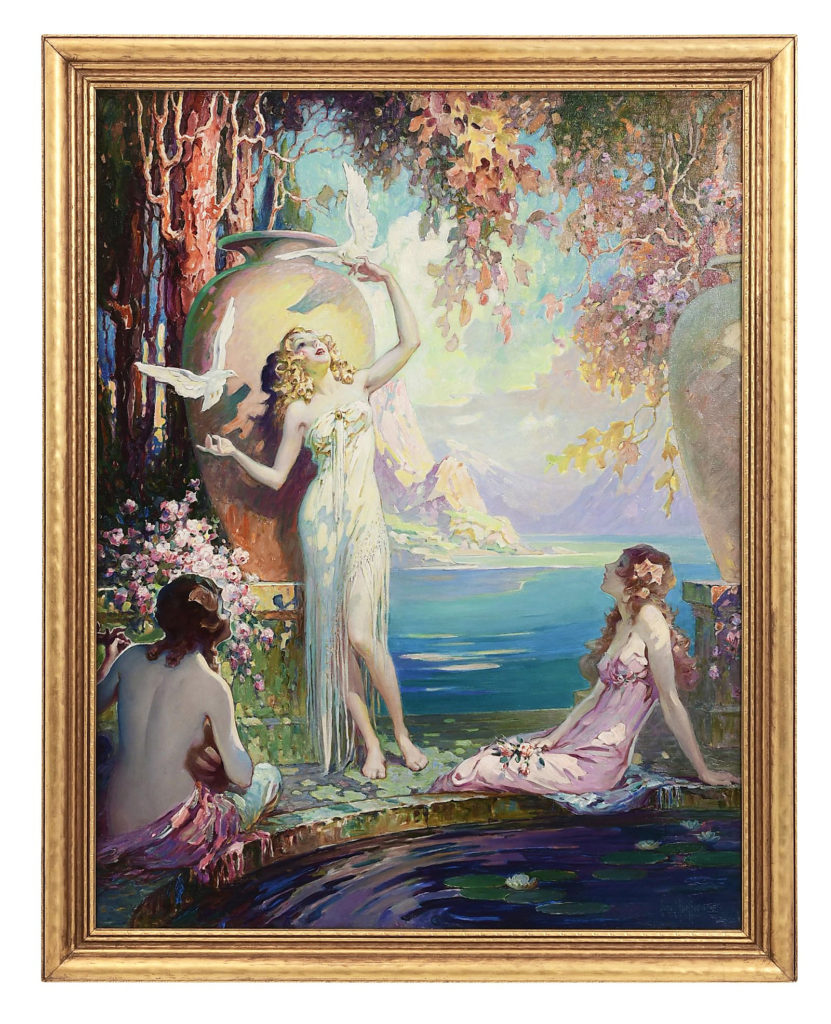
The “Three Graces by a Lily Pool,” an oil on canvas by Glenn Crawford Sheffer (1881-
1948), reached $5,313.
Did Fontaine’s quote above – “the name Tiffany still attracts” – hold true for this sale? Of the 34 highest prices paid on the first day of the sale, all but one was realized by something made by Tiffany. The sale’s highest price, $93,750, was earned by a boldly colored red, blue and green Poppy pattern table lamp on a bronze base. Both shade and base were signed Tiffany Studios. That was followed by a large Peony Border Tiffany chandelier, which sold for $87,500, and one of two Tiffany Dragonfly table lamps, selling for $81,250. John Fontaine explained that the hardware on the shade of the 24-inch blue and green chandelier indicated that it could either originally have been purchased as a shade for a floor lamp or as a chandelier. If it were designed to be sold only as a chandelier, the mounting hardware would have been different.
Fontaine said that Tiffany floor lamps and table lamps were sold primarily by Tiffany’s own stores and that customers could “mix and match” after deciding to purchase a shade and then selecting the base they preferred. Most shades were offered in different colors; thus, there were two Dragonfly table lamps of different coloring in this sale. Customers might prefer bold or muted colors, depending on the color scheme of the room in which they planned to use the lamp. Some lamps were sold to be used in offices or rooms, or sometimes in entire homes designed by Tiffany. One of the Dragonfly lamps, with a 16¾-inch shade, utilizing boldly colored blue and green glass and on a bronze base, earned $81,250. The other, with a mottled amber and green shade the same diameter, on a bronze oil lamp-style base, earned $62,500.
Another example of the differing colors and bases available was demonstrated by three Linenfold floor lamps. One with a deep amber shade on an Aladdin base sold for $12,500, and another, with a somewhat paler shade and on a base with smokers’ attachments, brought $8,750. This one had some minor condition issues. Fontaine’s large display of lamps, all in one room, made it simple for collectors to compare one lamp to another, and also provided a “good, better, best” study grouping.
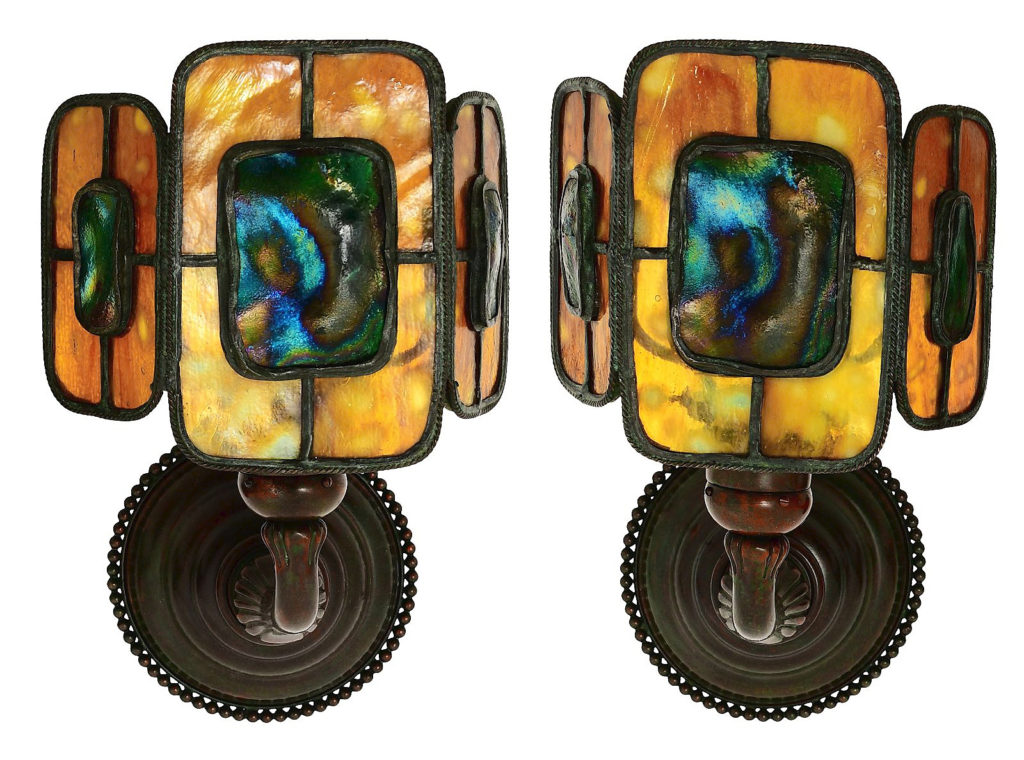
A pair of circa 1915 Tiffany Studios Turtleback sconces was the first lot sold and brought $16,250.
An excellent example of the “good, better, best” approach to collecting was provided by two Woodbine pattern table lamps. Collectors recognize that there are differences in the glass used for the shades. Selling for $75,000, one with a 16-inch shade utilized uncommon “confetti” glass, which required multiple steps in preparation and was noticeable both in the look and feel of the finished shade. It was on a “better” Crutch Oval base with an inlaid Turtle-Back band. The other Woodbine lamp had a 14-inch shade, was on a simple bronze base and it earned $20,000. There were four Vine Border table lamps, two with 16-inch shades and two with 14-inch shades. Bases differed, with $22,500, the highest price, being paid for one of the 16-inch shades on a Grueby pottery base. One of the other lamps, with a 14-inch shade on an electrified oil lamp base earned $5,625.
The listing of Tiffany lamps could go on as 29 lamps finished with five-figure prices, but there was also a strong selection of “Golden Age” furniture and accessories. For homes with the space for this furniture, according to Fontaine, this is a good time to buy. A carved R.J. Horner tall case clock topped the offerings, finishing at $27,500. The heavily carved oak case included caryatids, winged griffins, floral panels and more. Nearly 9 feet tall, its dial was brass, and it was marked Joseph Jennens / Skinner Street / Clerkenwell, London. The movement was marked Made in England, and the brass weights were visible through the beveled glass door. There were ten Horner pieces in the sale. That’s not quite accurate as one of the ten was a 12-piece heavily carved oak dining room set, with table, eight chairs, sideboard and more. The set earned $13,750.
Two Horner 87-inch-long leather covered carved mahogany sofas were sold separately, with one bringing $8,750 and its mate bringing $8,125. A large circa 1880 four-piece Eastlake bedroom set, including a two-door armoire, bed, marble-top dresser and marble-top commode realized $27,500. Each piece had beveled glass mirrors and was elaborately carved with filigree, scrollwork, flowers and seashells. The armoire was 108 inches tall and the bed was 93 inches tall. Two slightly different laminated rosewood John & Joseph W. Meeks armchairs were sold together and reached $8,750. One was in the Henry Ford design and the other was in the Hawkins pattern. A Hawkins sofa sold for $3,250. As is typical of laminated rosewood furniture, there were minor condition issues with these pieces. A laminated rosewood Belter matching pair of meridians brought $6,875. There was much more furniture of the period by other makers.
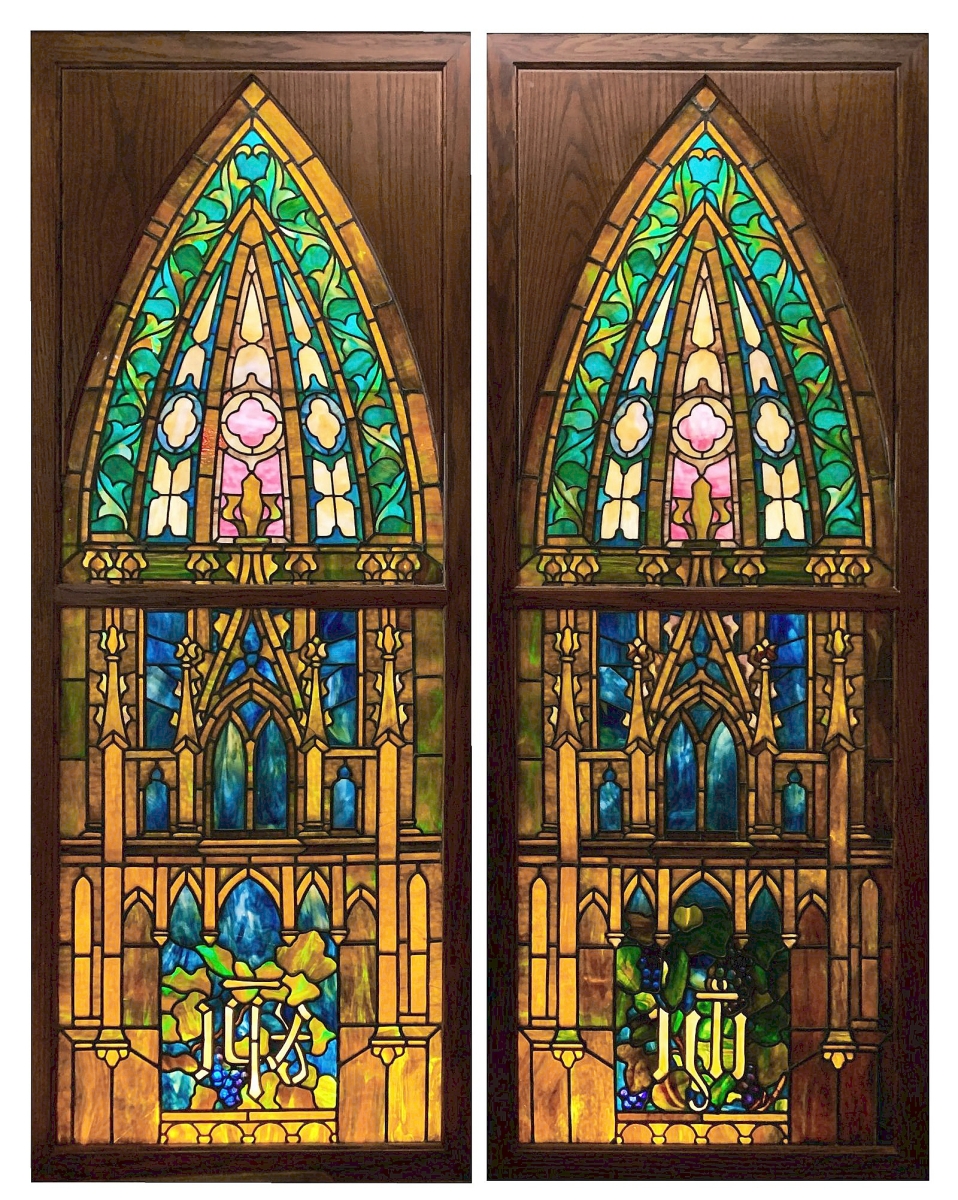
There were a number of leaded glass windows in the sale. An unmarked pair of plated and leaded Gothic revival windows, each circa 1910 window, 73 inches tall, was mounted in an oak frame; the pair earned $50,150.
The second day of the sale included jewelry, and a platinum and diamond bracelet led both the day and the category. Selling for $81,250, it had 48 emerald cut diamonds weighing approximately 26.11 carats, bordered by 82 round brilliant diamonds weighing approximately 19.06 carats. Mia Fontaine said it was her favorite piece in the sale. An eye-catching 22K yellow gold Indian necklace brought $3,250.
To complement the furnishings, the sale offered almost 90 oil paintings, both European and American. At $9,375, the most popular was a sunset cityscape of Iraq. It was dated 1907 and signed Ernst Koerner (1846-1927). He was known for his Middle Eastern landscapes.
The most desired of the American paintings, selling for $8,125, was a busy harbor scene with several fisherman by Jon Corbino (1905-1964). He was best-known for circus scenes with horses and riders, and his works are in the Smithsonian’s collection. Marine paintings included ship portraits of Hudson River steamboats by Albert R. Nemethy (1920-1998). He was a prolific artist, mostly working in the Hudson River Valley and is estimated to possibly have produced as many as 5,000 paintings. His portrait of the steamboat Central Hudson sold for $4,063, and a portrait of the steamer Mary Powell brought $2,000. White Mountain paintings included works by Edward Hill (1843-1923) and Benjamin Champney (1817-1907). A small painting of the Old Man of The Mountain by Hill sold for $5,625. A painting of Mount Washington with two repaired tears by Champney brought $3,000.
A few days after the sale, John Fontaine commented, “It went just the way we hoped it would and the market responded well. Other than some of the American paintings, which sold well over the estimates, there weren’t a lot of surprises. We think we understand the market and we try to estimate as accurately as possible and almost everything sold within the estimates. The $2.5 million gross is a good number, so I’d have to say it went well.”
Prices given include the buyer’s premium as stated by the auction house. For additional information, 413-448-8922 or www.fontainesauction.com.




































